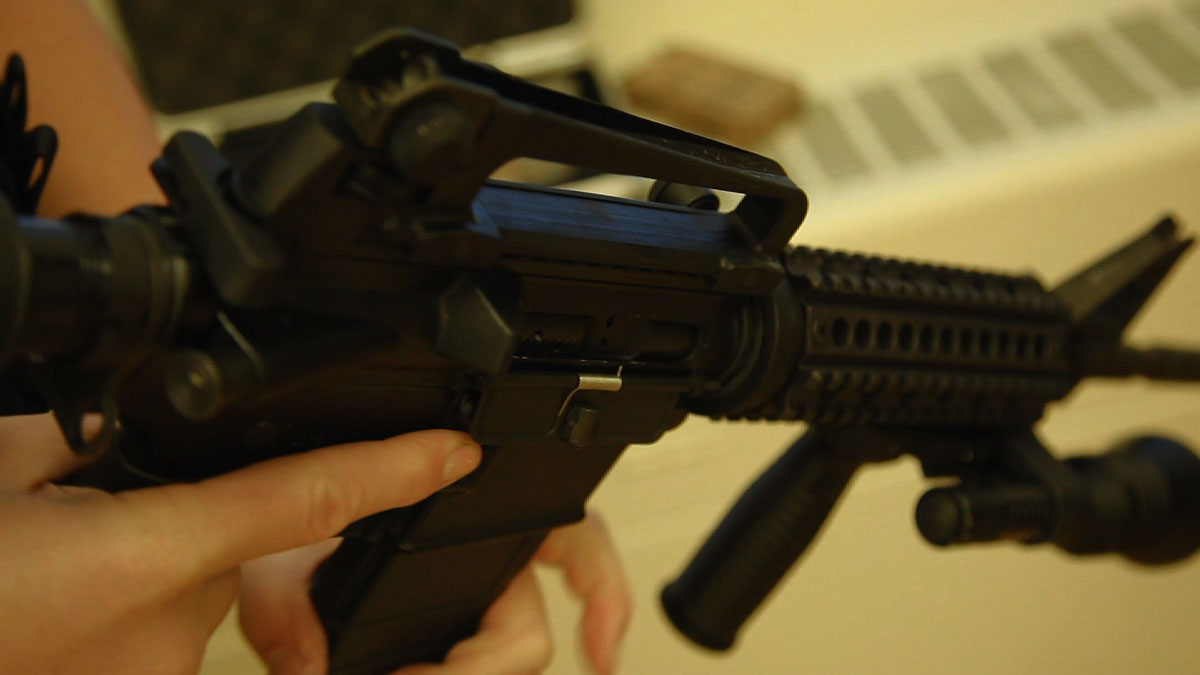“Point Blank: Carbines would’ve made a difference.” – Moncton RCMP officer

If there was one thing missing in Moncton the night of June 4, 2014, it was a carbine – a semi-automatic rifle.
A carbine could’ve leveled the playing field, giving first responders equal firepower to the killer, Justin Bourque, who was armed with an M305 semi-automatic rifle.
On June 4th, the Codiac detachment in Moncton only had six carbines, all of which were an hour and half away, being used in the first-ever carbine-user course in New Brunswick.
Without the more powerful rifle, frontline members were left with only their 9mm sidearm. A select few thought to grab a shotgun. Neither weapon is effective at long range, which meant Justin Bourque had a significant tactical advantage.
“You don’t bring a knife to a gun fight and here we are bringing a hand pistol to a rifle fight,” said a currently serving member, whose identity we are concealing to protect against possible discipline for openly criticizing the RCMP.
WATCH: How a 9mm sidearm and a shotgun compare to the patrol carbine
So why didn’t officers in Moncton have access to the carbine on June 4th?
For years, frontline members had been calling for the carbine, concerned about their safety when responding to gun calls.
“You look down at your 9mm and it doesn’t seem like the appropriate response,” another currently serving officer told 16×9.
WATCH: Nir Maman with the Canadian Tactical Officers Association explains the difference between a carbine, rifle and pistol
For years, reports had been expressing the same concern.
In the wake of the murder of four officers in Mayerthorpe, Alberta in March 2005:
Mayerthorpe Public Fatality Inquiry, March 3, 2011:
Mayerthorpe RCMP Incident Management Review, May 1, 2008:
After two more officers were gunned down in Spiritwood, Saskatchewan in July 2006.
HRSDC Hazardous Occurrence Investigation, August 29, 2007:
By the time these reports were released, other police agencies in Canada had already equipped their frontline officers with carbines.
The second largest police force in Canada, the Ontario Provincial Police, had fully deployed carbines to its frontline members by 2006. It even used the RCMP’s training facility to test the weapon. Today, there is a carbine in every OPP cruiser on the road.
WATCH: How effective is the carbine? Here’s a look at the rifle in action
Frontline members of the RCMP, meanwhile, couldn’t understand the standstill. After all, the RCMP already had several models of carbines approved for use, including the ‘C8’ manufactured by Colt, the model of carbine the RCMP would eventually roll out.
“The wheel does not need to be reinvented,” a 2009 memo to members wrote, “This is a critical public and member safety issue that needs to be addressed immediately!”
An internal memo between high-ranking officers suggests there was more at play.
An email sent among senior ranking officers in February 2009, suggests the carbine program was simply not a priority.
The “patrol carbine” was one of those lower priorities. – Former RCMP Deputy Commissioner Darrell Madill
It was sent while the RCMP was in the hot seat over the Taser scandal at Vancouver International Airport. A polish immigrant, Robert Dziekanski, died after being repeatedly Tasered by an officer using a CEW, or conducted energy weapon, in October 2007. The scandal left the force reeling and put under a microscope for its use of force practices.
While the RCMP was doing damage control, the carbine program dropped to the bottom of the list.
In the meantime, some frontline members took to bringing their own gun on the job because they didn’t feel secure with the level of weapon the RCMP was issuing. “I knew guys when I started that would carry a military rifle in their trunk,” one officer said, “I work with guys now that have done that.”
It wasn’t until 2011 that the carbine program officially began.
On the stand at the public inquiry into the Mayerthorpe killings, then Senior Deputy Commissioner Rod Knecht announced that frontline officers would get the rifle.
“I approved the rollout. I said, ‘We’ll immediately roll this out’,” Knecht told 16×9.
But today, even he admits the years of testing and discussion leading up to that announcement were too long.
WATCH: An extended interview with Rod Knecht, former Senior Deputy Commissioner of the RCMP
But the delays didn’t stop there.
According to Knecht, the rollout was only supposed to take 12-18 months after he hit ‘go’ in February 2011.
But the first major shipment of carbines didn’t arrive until mid-2013.
Knecht retired from the RCMP shortly after the program was announced and can’t account for the further delays.
To date, approximately 2200 carbines have been delivered across the country – to equip up to 12,000 regular members. There are more carbines at the Codiac detachment in Moncton than on June 4, 2014, although the RCMP will not disclose how many.
16×9 reached out to the RCMP numerous times for a sit-down interview about the carbine program, but our repeated requests were denied.
At this time, there are entire detachments in Canada without a single officer equipped with a carbine. And some frontline officers feel betrayed by the management they expected would protect them.
“I look at everybody else and wonder why it took so long – and how many more people we have to bury before everybody gets one.”
You can watch the complete investigation ‘Under Fire’ Saturday, March 28 at 7 p.m. on 16×9.
Next: Training for a shooting
- Life in the forest: How Stanley Park’s longest resident survived a changing landscape
- ‘They knew’: Victims of sexual abuse by Ontario youth leader sue Anglican Church
- Carbon rebate labelling in bank deposits fuelling confusion, minister says
- Buzz kill? Gen Z less interested in coffee than older Canadians, survey shows










Comments